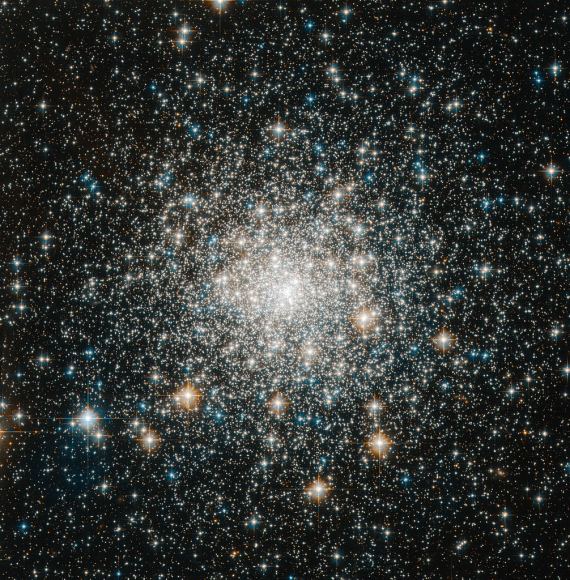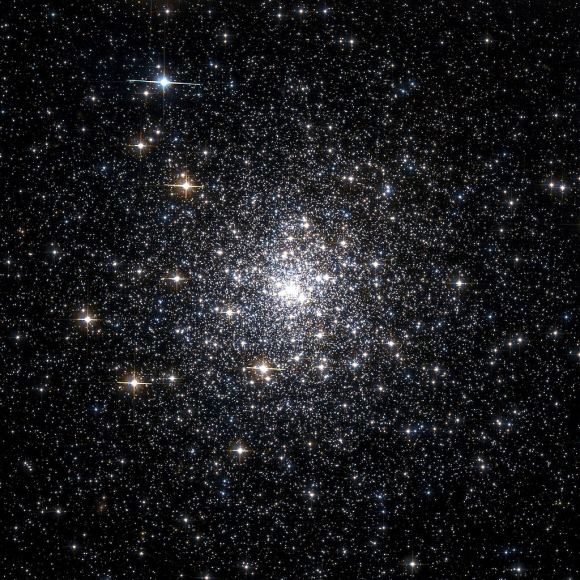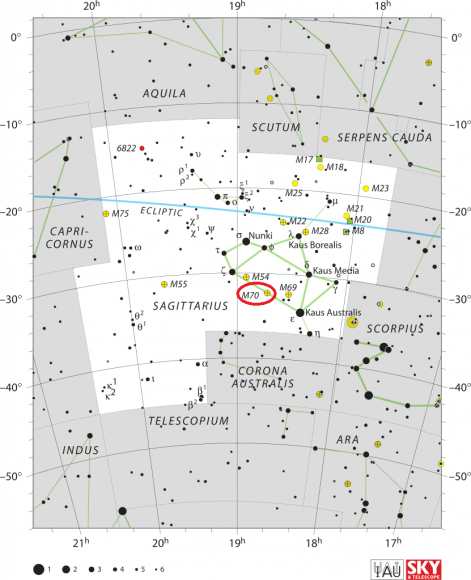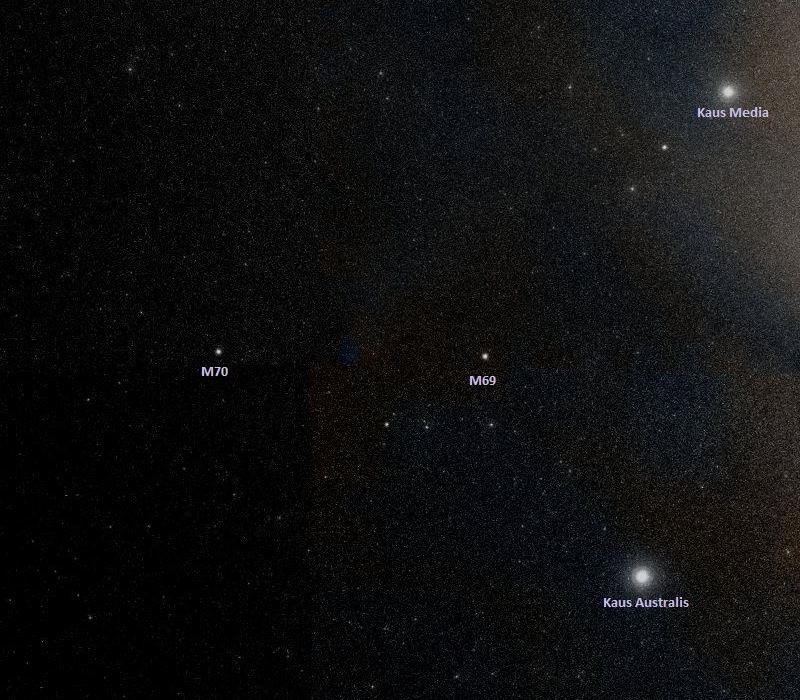Welcome back to Messier Monday! Today, we continue in our tribute to our dear friend, Tammy Plotner, by looking at the globular cluster known as Messier 70.
In the late 18th century, French astronomer Charles Messier spent much of his time looking up at the night sky in search of comets. Over time, he discovered 100 fixed, diffuse objects that resembled comets, but were something else entirely. Messier compiled a list of these objects, hoping to prevent other astronomers from making the same mistake. What resulted was the Messier Catalog, one of the influential catalogs of Deep Sky Objects.
One of the objects he catalogued is Messier 70 (aka. NGC 6681), a globular cluster located 29,300 light years away from Earth and close to the Galactic Center. It’s location within the asterism known as the “Tea Pot” (which is part of the northern Sagittarius constellation). It is also in close proximity to both the M54 and M69 globular clusters.
Description:
At around 29,300 light years from Earth and running away from us at a speed of 200 kilometers per second, this 68 light year diameter ball of stars is only slightly brighter than its neighboring globular cluster – M69. Even though it is being ripped apart by tidal forces from being so near to the center of our galaxy, M70 still has a super dense core region, perhaps the product of a core collapse at one point in its evolution. As W. Landman (et al.) indicated in a 1997 study:
“The post–core-collapse globular cluster NGC 6681 (M70) is characterized by an intermediate metallicity ([Fe/H] = –1.5), a low reddening (E(B–V) = 0.06), and a blue horizontal branch (HB). Photometry of the blue HB stars in the far-ultraviolet ( ~ 1600 Angstroms) images is in good agreement with the WFPC2 Woods filter photometry of Watson et al. (1994, ApJL, 435, L55). The F25CN182 — F25CN270 color-magnitude diagram shows a tight cluster of blue HB stars, a pronounced blue straggler sequence, and several white dwarf candidates.”

But what else lay within this unique globular cluster? Try interacting binary stars! As Andrea Dieball indicated in a 2008 study:
“We propose to carry out 70 ksec X-ray imaging of the globular cluster NGC 6681 with Chandra. This cluster was extensively observed in the FUV with HST, yielding the deepest FUV survey of a globular cluster to date. Our X-ray observations will allow us to (i) find X-ray counterparts to the white dwarf – main sequence star binaries in our ultra-deep FUV survey, thus identifying and confirming the cataclysmic variables amongst them; (ii) detect the X-ray faintest interacting binaries (IBs) in this cluster; (iii) classify all X-ray sources based on their X-ray, FUV and optical properties; (iv) and finally, using all the information obtained, test models for IB formation and evolution and verify the empirical results emerging from previous work on other clusters.”
By closely studying globular clusters such as M70 within our own galaxy, we can get a much better feel for how they age and evolve – giving us a basis for which we can use to study the evolution of other galactic structures. As F. Meissner and A. Weiss explained in their 2006 study:
“The determination of globular cluster (GC) ages rests on the fact that colour-magnitude-diagrams (CMD) of single-age single-composition stellar populations exhibit specific time-dependent features. Most importantly, this is the location of the turn-off (TO), which – together with the cluster’s distance – serves as the most straightforward and widely used age indicator. However, there are other parts of the CMD, which change their colour or brightness with age, too. Since the sensitivity to time is different for the various parts of the cluster CMD, it is possible to either use various indicators independently, or to use the differences in colour and brightness between pairs of them; these latter methods have the advantage of being distance independent.”

Is this age and dating thing important? You bet. As Solaris and Weiss explained why in their 2002 study, they help astronomers determine the age of the Universe:
“Less than a decade ago the age of the oldest globular clusters appeared to be much higher than that of the expanding universe. But at the end of the last millennium significant improvements both in models and in observational data, notably in the determination of cluster distances by virtue of Hipparcos-based distances, lead to a reduction of cluster ages. Presently, most determinations scatter around a typical age of the oldest objects of 12–14 Gyr. With the growing confidence in the absolute age determinations and an increasing number of extensive homogeneous and high-quality photometric cluster data, the interest has shifted to questions concerning relative ages in order to learn about the formation of the galaxy and its halo and disk components.”
History of Observation:
M70 was discovered by Charles Messier and added to his catalog on August 31, 1780, the same night he found M69. In his notes he states:
“Nebula without star, near the preceding [M69], & on the same parallel: near it is a star of the ninth magnitude & four small telescopic stars, almost on the same straight line, very close to one another, & [they] are situated above the nebula, as seen in a reversing telescope; the [position of the] nebula was determined from the same star Epsilon Sagittarii.’ (diam 2′)”.
On July 13, 1784, Sir William Herschel would be the first to resolve M70 into stars, but his private notes include a very odd entry: “A very faint red perceivable.” No where else in historic observations does this occur again! M70 would go on to be observed many times by W. Herschel and to be cataloged by son John as “Bright; round; gradually much brighter toward the middle.”

Locating Messier 70:
Because the constellation of Sagittarius is so low for the northern hemisphere, it is best to wait until it is at culmination (its highest point) before trying for this small globular cluster. Begin by identifying the familiar teapot asterism and draw a mental line between its southernmost stars – Zeta and Epsilon. About halfway the distance between Epsilon and Zeta (and due south of Lambda) is the location of M70.
In binoculars, M70 will appear almost stellar and very faint – like a hairy star that won’t quite resolve. To a small telescope it will appear cometary and begin resolution in apertures around 8″. It requires dark, transparent skies and is not well suited to moonlight or urban lighting situations.
Enjoy your observations!
And here are the quick facts on this Messier Object to help you get started:
Object Name: Messier 70
Alternative Designations: M70
Object Type: Class V Globular Cluster
Constellation: Sagittarius
Right Ascension: 18 : 43.2 (h:m)
Declination: -32 : 18 (deg:m)
Distance: 29.3 (kly)
Visual Brightness: 7.9 (mag)
Apparent Dimension: 8.0 (arc min)
We have written many interesting articles about Messier Objects here at Universe Today. Here’s Tammy Plotner’s Introduction to the Messier Objects, M1 – The Crab Nebula, and David Dickison’s articles on the 2013 and 2014 Messier Marathons.
Be to sure to check out our complete Messier Catalog. And for more information, check out the SEDS Messier Database.
Sources:


I missed you, Messier Monday!